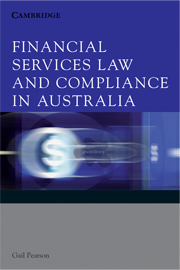Book contents
- Frontmatter
- Contents
- Preface
- List of Abbreviations
- Table of Statutes
- Table of Cases
- 1 The financial citizen and the market
- 2 The regulatory structure
- 3 An overview of financial services reform
- 4 Licensing financial services providers
- 5 The role of disclosure in the distribution of financial products
- 6 Selling financial products and other conduct
- 7 Deposit-taking and payments
- 8 Investment
- 9 Insurance
- 10 Consumer credit
- 11 Superannuation
- 12 Compliance, enforcement and remedies
- Index
- References
1 - The financial citizen and the market
Published online by Cambridge University Press: 05 June 2012
- Frontmatter
- Contents
- Preface
- List of Abbreviations
- Table of Statutes
- Table of Cases
- 1 The financial citizen and the market
- 2 The regulatory structure
- 3 An overview of financial services reform
- 4 Licensing financial services providers
- 5 The role of disclosure in the distribution of financial products
- 6 Selling financial products and other conduct
- 7 Deposit-taking and payments
- 8 Investment
- 9 Insurance
- 10 Consumer credit
- 11 Superannuation
- 12 Compliance, enforcement and remedies
- Index
- References
Summary
We're all Warren Buffetts now.
Laws regarding financial services touch on many themes. The financial services market is the domain of many disciplines, including economics, regulatory theory and politics. The Australian financial services market is both sophisticated and global. Its financial services expertise is exported. Australia has the fourth largest funds management industry after the US, the UK and Luxembourg. It has the eighth largest stockmarket. At least 55 per cent of adult Australians either directly or indirectly hold shares through managed funds or self-managed superannuation funds. The Australian Stock Exchange (ASX) believes that this is ‘the highest reported level of retail share ownership in the world’. Most importantly, all employed Australians contribute to the market through compulsory superannuation in a unique system with no social security levy and a strictly means-tested old age pension scheme. Superannuation is the largest asset class held by retail investors, who may choose which superannuation fund holds their asset. There has been a shift from readily accessible deposits to ‘locked up’ superannuation; as a result, households now hold more assets in superannuation than in deposits. In parallel with this development (which has given individuals the freedom to determine their own financial future for retirement) was an earlier freeing up of the paternalistic restraints which Australian governments once imposed on financial institutions lending to individuals There is a corresponding and steady increase in consumer debt, much of it for housing and investment housing, though there are intermittent concerns about credit card debt.
- Type
- Chapter
- Information
- Financial Services Law and Compliance in Australia , pp. 1 - 19Publisher: Cambridge University PressPrint publication year: 2009



